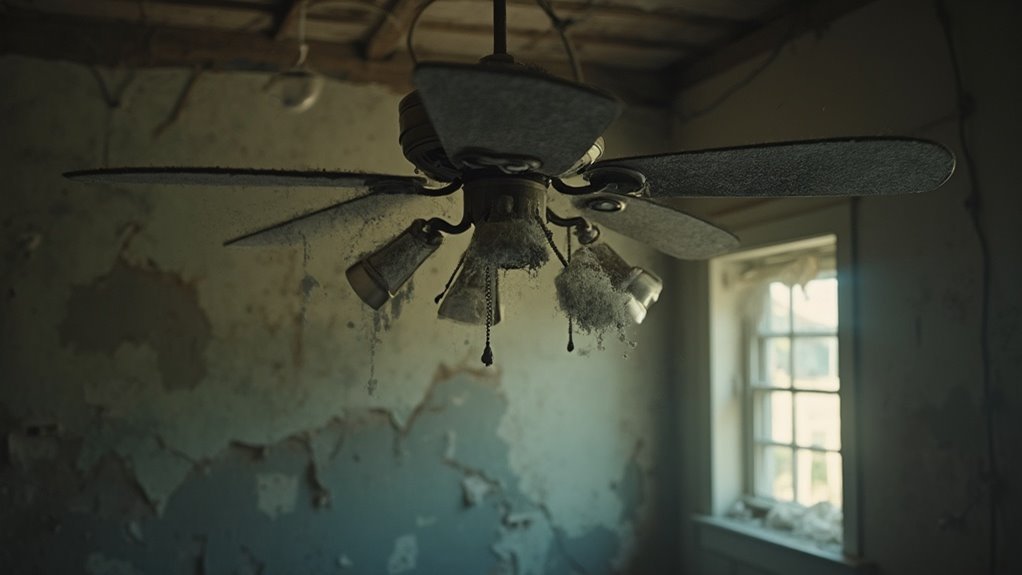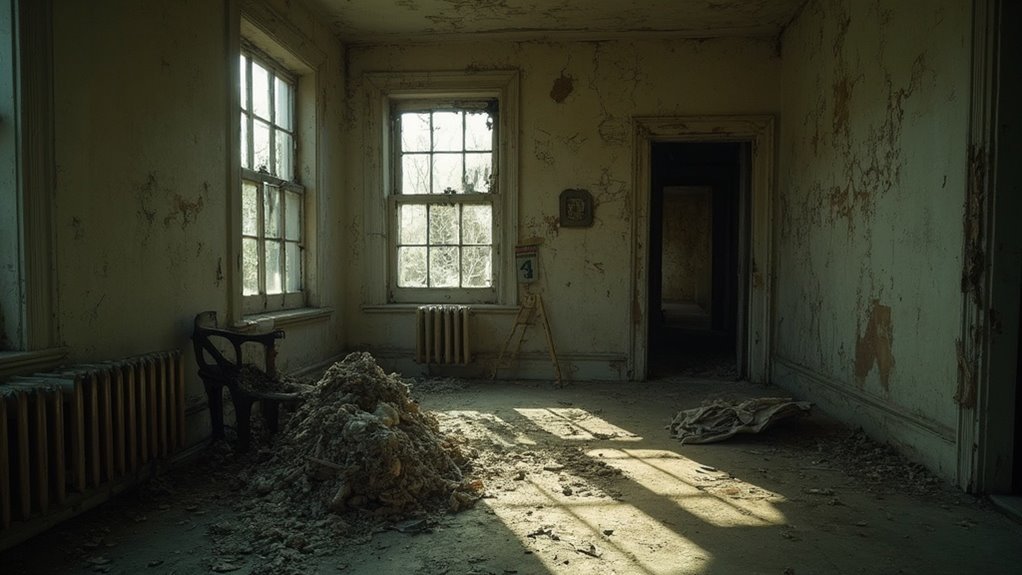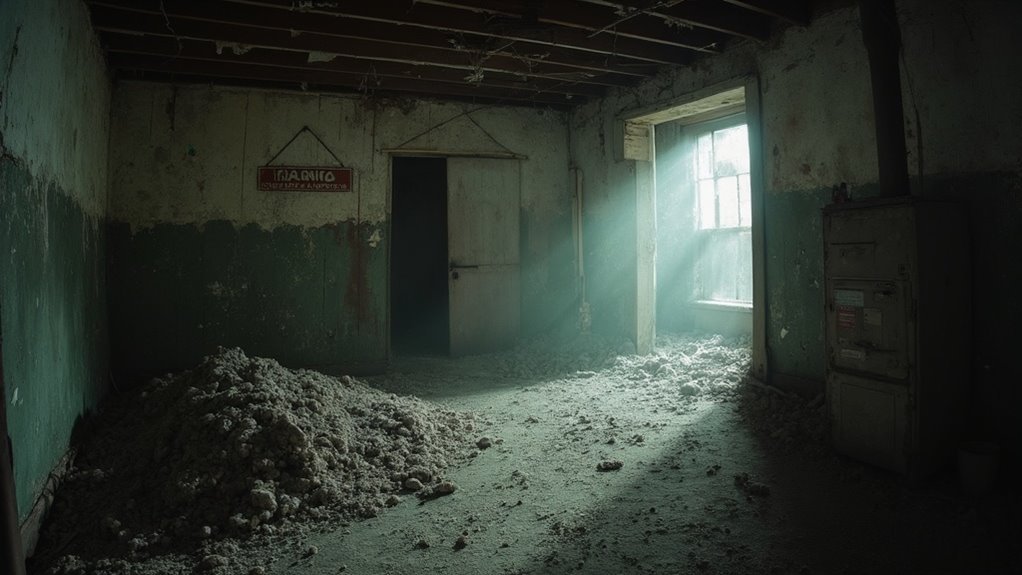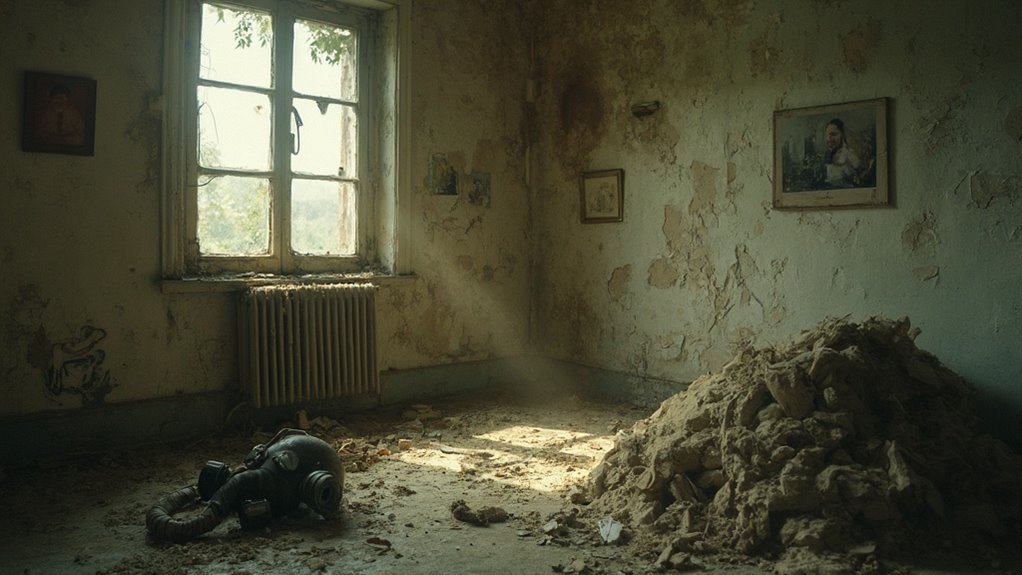Ignoring asbestos testing in older homes poses serious health risks, including respiratory diseases like lung cancer and asbestosis. Exposure to asbestos fibers, often hidden in materials like insulation or flooring, can occur during renovations or daily activities, particularly in attics and basements. Prolonged exposure increases your cancer risk considerably, with symptoms appearing decades later. Furthermore, failing to test can lead to legal liabilities and costly remediation efforts. It's vital to take proactive measures to guarantee your safety and compliance. Understanding the specific dangers can help you protect your health and home effectively. More insights await you on this important topic.
Understanding Asbestos Health Risks

Asbestos exposure poses serious health risks, contributing to various respiratory diseases that can considerably impact your quality of life. Understanding the history of asbestos is essential, as its widespread use in construction and manufacturing has left many homes at risk. Asbestos fibers, when inhaled, can lead to severe conditions such as asbestosis, mesothelioma, and lung cancer. These diseases develop over time and often result from prolonged exposure, highlighting the importance of adhering to health guidelines regarding asbestos testing and removal. Early detection of asbestos is vital for preventing long-term health complications and ensuring safety in your home.
Key factors influencing your health risks include your smoking history and any pre-existing lung conditions. The severity of exposure can vary based on the type and duration of asbestos fibers you're exposed to, emphasizing the need for vigilance in older homes. Statistics reveal alarming trends, with over 200,000 deaths globally from occupational exposure each year, a number that underscores the urgency for action. No safe level of asbestos exposure exists, making it crucial to test your home for this hazardous material.
Sources of Asbestos Exposure
When you step into an older home, it's essential to be aware of potential sources of asbestos exposure lurking within its walls. Asbestos identification is critical for your safety. Common locations include attics with vermiculite insulation, basements with contaminated walls, and crawl spaces showcasing exposed asbestos insulation. Ceilings often hide textured paint or ceiling tiles that could contain asbestos, while walls may feature asbestos-containing plaster or panels.
Certain materials are more likely to harbor asbestos, such as roofing felt for shingles, cement asbestos board siding, and vinyl floor tiles. Be cautious during DIY renovations; handling or disturbing these materials can lead to exposure. Activities like drilling through drywall, replacing old pipes, or even addressing water damage can release harmful fibers into the air.
High-risk areas include attic renovations involving vermiculite insulation removal and garage activities with older vehicles that have asbestos brakes or clutches. For insulation safety, be mindful of maintaining and removing damaged materials. Understanding these sources can help you take proactive measures to protect yourself and your loved ones from the dangers of asbestos. Additionally, even low-level exposure can be harmful, making proper handling and removal essential for safety.
Importance of Asbestos Testing

Understanding the importance of asbestos testing can't be overstated, especially given the severe health risks associated with exposure. Ignoring testing can lead to lung cancer and other respiratory issues, making it essential to act proactively. By opting for professional testing, you not only safeguard your health but additionally guarantee compliance with regulations, preventing future legal and financial headaches.
Health Risks Overview
While many older homes may appear charming and full of character, hidden dangers like asbestos can pose significant health risks if left unchecked. Asbestos was historically used in construction because of its fire-resistant properties, but the reality is that exposure to asbestos fibers can lead to severe health issues, including lung cancer and mesothelioma. It's vital to dispel common asbestos myths that suggest these risks are exaggerated.
Here are some key health risks associated with asbestos exposure:
- Increased Cancer Risk: Prolonged exposure can greatly enhance your chances of developing lung cancer.
- Asbestosis: This chronic lung condition can cause symptoms like shortness of breath and a persistent dry cough.
- Late-Onset Illnesses: Many asbestos-related diseases can take decades to manifest following exposure.
- Deterioration Risks: Asbestos materials in older homes can release harmful fibers when disturbed, especially during renovations.
Understanding these health risks underscores the importance of thorough asbestos testing in older homes. Ignoring potential asbestos hazards could lead to devastating health consequences, making proactive measures fundamental for your safety.
Professional Testing Benefits
Asbestos testing in older homes is an essential step in safeguarding your health and the wellbeing of residents. Engaging professionals for an asbestos assessment guarantees compliance with local regulations, especially in states like Oregon, where testing is mandatory before demolition in homes built before 2004.
By utilizing advanced testing techniques, trained inspectors can accurately identify areas of concern, preventing the unintended release of dangerous asbestos fibers into the air. This proactive approach not only mitigates health risks but likewise minimizes potential legal complications that could arise from asbestos contamination.
Professionals are equipped to handle asbestos materials safely and provide detailed reports outlining necessary remediation actions. Their expertise guarantees that hidden asbestos-containing materials are identified before renovations, safeguarding both contractors and residents.
Furthermore, thorough testing improves indoor air quality, protects the long-term health of occupants, and can even increase property value by documenting a clean inspection. Ultimately, investing in professional asbestos testing creates peace of mind, assuring a safer living environment while addressing any asbestos risks early on.
Risks of DIY Removal
When you attempt DIY removal of asbestos, you risk releasing dangerous fibers into the air, which can lead to severe health issues. Improper safety protocols can worsen this danger, making it vital to understand the legal consequences you may face if things go wrong. It's important to weigh these risks carefully before deciding to tackle asbestos removal on your own.
Dangerous Fiber Release
Many homeowners underestimate the risks associated with DIY removal of asbestos-containing materials (ACMs). When you disturb these materials, especially if they're damaged or deteriorated, you can release dangerous asbestos fibers into the air. This can greatly increase your exposure risks, putting your health and that of your family in jeopardy.
Consider these essential factors before attempting any DIY removal:
- Damaged or fraying ACMs are more likely to release harmful fibers.
- Undisturbed materials in good condition typically pose little risk.
- Unqualified individuals may lack the necessary training and equipment.
- Sampling by untrained individuals can be riskier than leaving the material undisturbed.
Handling ACMs without proper knowledge can lead to inhalation of asbestos fibers, which is linked to severe health issues like asbestosis, lung cancer, and mesothelioma. Even small amounts can be dangerous. If you suspect the presence of asbestos, it's vital to consult a trained professional for testing and removal. Ensuring safety should always take precedence over DIY efforts, as the consequences of exposure can be lifelong and devastating.
Improper Safety Protocols
Attempting DIY removal of asbestos can lead to serious safety oversights that put you and your family at risk. Many homeowners underestimate the dangers associated with improper equipment and safety negligence during the removal process. Without proper personal protective equipment (PPE), you expose yourself to harmful asbestos fibers that can linger in the air and infiltrate your lungs.
Untrained individuals often lack the necessary knowledge to handle asbestos safely, leading to the use of methods that generate excessive dust. This not only increases airborne asbestos but additionally heightens the risk of exposure. While you might think that wetting down the material will mitigate risks, without the right training, you could still release hazardous fibers unintentionally.
Moreover, sealing off the area and utilizing negative pressure systems are critical steps that many DIYers overlook, allowing dangerous fibers to spread throughout the home. Inadequate testing might leave hidden asbestos hazards undetected, exacerbating the risk of long-term health issues. The complexities of asbestos removal aren't just a mere inconvenience; they can have life-altering consequences. Always consider professional help to guarantee safe and compliant abatement.
Legal Consequences Involved
Legal consequences of DIY asbestos removal can be severe and far-reaching. Ignoring regulatory standards not only endangers your health but additionally exposes you to significant legal repercussions. Here are some critical points to reflect on:
- In the UK, improper removal can lead to fines up to £20,000 and 12 months of imprisonment.
- Some regions, like the ACT, only allow licensed asbestos removalists to handle asbestos.
- Even where DIY removal is permitted, you must demonstrate competency and use the right equipment.
- In the U.S., federal laws like NESHAP and AHERA mandate specific notification and training requirements for asbestos removal.
Failing to conduct asbestos testing or improperly managing asbestos can result in hefty fines, costly lawsuits, and damage to your reputation. Non-compliance can shut down work sites, leading to project delays and financial burdens. Moreover, insurance policies often exclude asbestos-related work, leaving you liable for cleanup costs. The expense of hiring certified professionals is often a fraction of the potential financial consequences of neglecting asbestos regulations. Prioritize safety and legal compliance to avoid the dire repercussions of DIY asbestos removal.
High-Risk Areas for Exposure

While renovating or maintaining an older home, you should be aware of several high-risk areas where asbestos exposure may occur. Vinyl flooring and insulation are significant concerns, particularly if they're damaged. Vermiculite attic insulation, along with insulation around older pipes, can release hazardous fibers when disturbed. Ceiling tiles installed between the 1950s and 1970s often contain asbestos, and the same goes for roofing materials. If you're planning repairs, be cautious with textured paints and popcorn ceilings, since they may likewise pose a risk.
Floor and wall materials, including drywall and adhesives, can harbor asbestos, especially during renovations involving cutting or drilling. Crawl spaces and basements are common locations to find this material. Furthermore, garages can be risky owing to older car parts, like brake pads, containing asbestos. Outdoor areas near natural asbestos deposits can lead to exposure during gardening or play.
Understanding these high-risk areas is essential for complying with asbestos regulations and ensuring safety during home renovations. Always consider asbestos testing before starting any project to protect yourself and your family.
Preventive Measures to Consider
Taking preventive measures is crucial for homeowners dealing with older properties that may contain asbestos. Ensuring a safe living environment involves a few key steps. Start by identifying asbestos-containing materials through thorough home inspections, especially in homes built before the 1980s. Conducting a risk assessment will help you understand the condition of these materials and evaluate any upcoming renovations.
Here are some preventive measures to take into account:
- Leave Suspected Materials Undisturbed: Avoid touching or attempting repairs on materials that may contain asbestos.
- Use Proper Protective Gear: If you're handling or near asbestos, always wear HEPA masks, gloves, and goggles.
- Consult Professionals: Hire trained asbestos inspectors for accurate material identification and testing.
- Encapsulate When Necessary: Seal asbestos materials with specialized coatings to prevent fiber release.
The Cost of Ignoring Testing

Ignoring asbestos testing in older homes can lead to significant financial and health repercussions. The costs of not addressing this issue can escalate quickly. If you skip testing, you risk exposure to asbestos, which can result in severe health problems like lung cancer, asbestosis, or mesothelioma. Furthermore, if you decide to undergo renovations without testing, you might unknowingly disturb asbestos, leading to expensive asbestos removal costs ranging from $1,000 to $3,000 or more.
You should also be aware of the legal implications. Failing to comply with testing regulations can result in fines up to $25,000 per day, further straining your finances. While the average cost for asbestos testing is around $482, it can range from as low as $100 to nearly $2,000, depending on your home's size and location.
Legal Liabilities and Responsibilities
Understanding your legal liabilities and responsibilities regarding asbestos is crucial for homeowners and property owners alike. Ignoring these obligations can lead to severe consequences, including legal action and financial penalties.
As a homeowner, you have specific obligations that include:
- Ensuring the safety of your home for occupants and visitors.
- Disclosing the presence of asbestos if you sell your property.
- Properly handling and remediating asbestos to prevent exposure.
- Being liable for any health issues that arise because of negligence.
For property owners, responsibilities extend further. You're expected to:
- Keep premises safe and inform the public about asbestos risks.
- Hire certified asbestos abatement companies when necessary.
- Comply with local and federal regulations to avoid criminal charges.
- Accept liability for contractors and visitors exposed to asbestos on your property.
Failure to meet these obligations can result in lawsuits for negligence or breach of duty. If you're unsure about your responsibilities, consider consulting a legal expert to navigate the complexities of asbestos law and protect yourself from potential liabilities. Taking proactive steps now can save you from significant legal troubles later.
Steps to Take After Testing

What should you do after testing positive for asbestos? First, seal air ducts and disable your HVAC system to prevent any fiber spread. Next, securely seal off the affected areas using thick plastic sheets to maintain an air pressure differential, and guarantee proper filtration. Before any work begins, an industrial hygiene firm should inspect the preparation to confirm safety protocols are in place. Don't forget to notify local authorities and obtain necessary permits.
During the removal process, employ appropriate removal techniques. For small amounts, glove bag removal works well; for larger areas, use negative pressure enclosures and wet removal techniques to minimize fiber release. Ascertain all contractors wear protective clothing and respirators, and set up a decontamination chamber with a shower for safe exit.
After removal, focus on cleaning and clearance. Use HEPA vacuuming and wet methods to minimize asbestos fiber dispersal. Conduct independent inspections and air sampling to verify safety. Keep barriers and air filtration in place until clearance testing is complete, assuring the work area meets safety standards before removing any protective barriers. Following these steps guarantees your safety and peace of mind.
Frequently Asked Questions
How Can I Identify Asbestos in My Home Without Testing?
To identify asbestos without testing, look for visual clues in materials older than the 1970s. Check for fibrous textures, wavy patterns, or chalky surfaces, especially in flooring, insulation, and textured ceilings. Stay cautious!
What Should I Do if I Find Asbestos During Renovations?
If you find asbestos during renovations, don't disturb it. Limit access to the area, and hire a trained professional for safe handling and asbestos removal. They'll guarantee proper procedures to minimize risks and protect your health.
Are There Any Legal Requirements for Asbestos Testing Before Selling a House?
While there's no federal requirement for asbestos testing before selling a house, you must comply with state asbestos regulations. Ensuring property disclosure about known asbestos can protect you from legal liabilities and improve buyer trust.
How Long Does Asbestos Testing Typically Take?
"Time and tide wait for no man." Asbestos testing duration usually spans several hours for sampling and up to a week for results, depending on the testing process timeline and lab efficiency. Stay informed and proactive.
What Qualifications Should I Look for in an Asbestos Removal Professional?
When selecting an asbestos removal professional, confirm they meet asbestos certification standards and possess removal experience credentials. Check their training and licensing to verify they're qualified for safe and effective asbestos abatement work.
